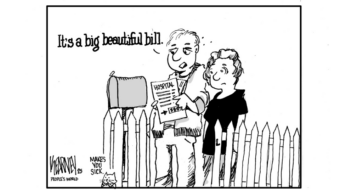Love handles and bulging waistlines are a big problem in America that can only be solved, a growing number of politicians are telling us, with some hefty “fat taxes.”
Here in Chicago we are about to see enactment of sharp new tax hikes on soft drinks and candy bars.
Politicians who tremble in fear at the suggestion that we make people with high incomes pay a bit more for health care reform have no fear when it comes to taxing the sugary foods and drinks that make people fat. Their argument is that a fat tax is just what the doctor ordered because expenditures for health care wouldn’t be so horribly out of control if people just worked harder at watching their weight and their argument is being fed by sources at high levels. So much so, that it is becoming conventional wisdom.
Backing them up, two major studies in the last month linked overweight and obese people to rising health care costs. Treating overweight patients, the federal Centers for Disease Control said in a late July report, adds as much as $147 billion annually to national health care spending. A study from the Urban Institute and the University of Virginia puts the impact of obesity-related issues at closer to $200 billion a year.
Obesity, the CDC researchers note, “continues to impose an economic burden on both public and private payers.” The “connection between rising rates of obesity and rising medical spending,” they add, has become “undeniable.”
Why have obesity rates been rising so much?
Is it because we all just like to eat too much or is there something else at work?
A political mentor I had many years ago warned me to look for the answer to every question, to every problem I ever had from the “class angle.” It’s the only way to figure out what’s going on, she said.
Of course, when you research what’s available in print you often get anything but “class angle” analysis. A case in point was what the New Yorker’s Elizabeth Kolbert wrote last month: “Something big must have changed in America to cause so many people to gain so much weight so quickly. But what, exactly, is unclear – a mystery batter-dipped in enigma.”
“Clever phrasing, but not very helpful,” I thought.
Kolbert declared the problem a mystery because from the time reliable national data on overweight Americans first became available, in the early 1960’s, and for the 20 year period after that, the share of Americans who were overweight barely inched up at all.
Suddenly, in the 1980’s American waistlines started expanding at an almost incredible pace. The nation’s adult obesity rate, according to the National Center for Health Statistics, jumped from 15 percent in 1980 to 23 percent in 1994 to 35 percent in 2006.
Analysts not schooled in looking for “class angles” offered a variety of explanations for this sharp increase: Fattening fast food has become cheaper, relative to other foods; restaurants are super-sizing portions; and corporate food giants have re-engineered food products to maximize their most addictive fat, sugar and salt.
All these factors operate on a national level and all, I’m sure, contribute to the growing number of obesity cases. There is a lot more, however, that they don’t explain.
Why, for example, do some states in the United States have a higher percentage of obese adults than other states. To extend the question on a more global scale, why do many other developed countries have much less obesity than we have in the United States?
So what is really going on?
It turns out that the differences in obesity rates between states and nations follow a consistent pattern. The more unequal the income distribution in a country, the more obesity. Simply put, inequality makes people fat.
Obesity follows what epidemiologists – scientists who study the health of populations – call a social gradient. Levels of obesity, in developed societies, rise as income and social status fall. On each step of the economic ladder, people tend to be more overweight than people on the steps above them.
The claim we read on the right wing blogs and hear from the right wing talking radio heads is that “low class” people “choose” to be unhealthy. Researchers disagree. People typically practice unhealthy behaviors not because they want to be unhealthy, but because they desperately need relief from social stress.
Typical responses to stress include taking relaxants, drinking alcohol, taking disinhibitors and stimulants, smoking, doing drugs and eating “comfort foods,” loaded with fat and sugar.
The more chronic the stress, the more likely a reliance on one or another or a combination of these comforting props. And the stress becomes more chronic as societies become more unequal in income.
In America income inequality exploded into a rapidly widening gap between 1980 and the period we are now in. For most of those 30 years the government was under the control of the ultra-right, doing all it could to further that gap to the advantage of the rich. It is precisely that period during which obesity rates rose from 15 percent to 35 percent of the adult population.
In our present day developed societies calories abound and high social status comes to those who can afford to stay very fashionable slim. It’s almost a reversal of what it was generations ago when only the affluent could afford to become the “fat cats” they were described to be.
None of this is to say that our society wouldn’t be a healthier and better place if more people became slimmer. We must give credit to the many health professionals who work so hard to educate people about the risks of excess weigh.
Two well known epidemiologists, however, Richard Wilkinson and Kate Pickett, say that by only focusing exclusively on individual obesity and treatment and prevention, we are overlooking why people engage in unhealthy behaviors in the first place.
What they are saying is that in the United States, obesity and inequality both started soaring in the 1980’s – after the “Reagan revolution.” If inequality continues to widen that gap, and deepen the stress among us, all the extra pounds on so many millions of people are unlikely to come off any time soon.
A final note on the progressive health care surtax on the rich that so many fat taxers would prefer to avoid. Now that we know that in order to become more healthy we have to become more equal why not go ahead with that idea of taxing the rich to help pay for health care reform.? It’s a sure way to help a lot more of us become a bit trimmer!










